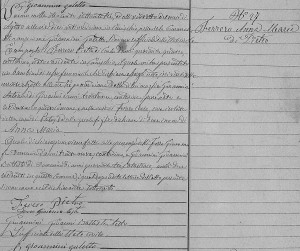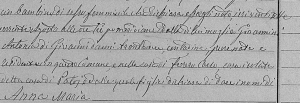
Until 1875, birth records in Canischio, Italy were completely written out by hand. They followed the same general pattern and used similar verbiage. With a little practice it’s relatively easy to skim a record quickly to pick out the information you are looking for. This is a quick guide to reading and translating birth records produced in Canishio prior to 1875.
In addition to the name of the child, his birthdate, his birthplace, and his parents, birth records sometimes include the ages and professions of the parents and the names of the paternal and maternal grandfathers.
Births were generally reported by the child’s father the day after the birth. Occasionally, births were reported the day of the birth, or (less commonly) two or more days later. If for some reason the father was not the informant for the birth, a midwife or other relative of the parents reported the child’s birth. The birth records will usually identify the relationship between the child or mother of the child and the informant.
Another thing to notice about birth records is the difference between civil records and ecclesiastical records. As you would expect, the records archived in the Italy, Torino, Ivrea, Civil Registration are generally civil records. However, among the marriage packets you will often find transcriptions of church baptism records in place of civil birth records. These ecclesiastical records contain the same basic information, though sometimes in a slightly different order or phrasing.
So let’s look at the anatomy of a birth record. Here is a record for Anna Maria Ferrero.

You’ll notice in the margin “No. 27 Ferrero Anna Maria di Pietro.” The names in these records are usually written surname first. This margin notation helps you navigate in the larger group of birth records from 1873. Anna Maria’s was the 27th record of the year. The phase “di Pietro” tells you that her father is named Pietro and that he is living. If her father were already deceased, the phrase would be “fu Pietro.” The margin can be very helpful in navigating through the set of records, but shouldn’t be relied on exclusively as a source of data. For instance, sometimes additional middle names are included within the record itself or mistakes are made in the margins that are corrected within the record. If the information in the margin is at all inconsistent with the information within the record, it is best to find another type of record to help reconcile what is actually correct.

Birth records always begin with the date, time, and place that the birth was reported. This is very rarely the date of the actual birth. In this instance we see the phrase L’anno mille ottocento settantatre ed vent’otto de mese di Agosto alle ore dieci antimeridiane in Canischio, nella Sala Comunale. The first words give us the year 1873 (mille ottocento settantatre) on the 28th of August (vent’otto de mese di Agosto). We also can see that the birth was reported at 10 a.m. (ore dieci antimeridiane) at the town hall in Canischio. For help translating the dates, see my post Cheat Sheet – Italian Dates and Numbers.

After this paragraph regarding the date, time, and place, we generally will find a new paragraph beginning with the word E comparso il, or a variation, followed by a name. This phrase tells us who appeared to report the birth. At this point in the record we will also be able to glean quite a lot of information about the informant. In this case, the person who appeared is “Ferrero Pietro di Carlo d’anni quaranta quarto, contadino, nato e residente in Canischio.” So Pietro Ferrero has come to report the birth of a child. The phrase “di Carlo” tells us that Pietro’s father is named Carlo and that Carlo is still living on this date. The phrase “d’anni” tells us the age of a person. At this time, Pietro is forty-four. After his age, we have Pietro’s profession, “contadino,” which translates as “farmer.” Contadino is by far the most common profession throughout most of the records, however you will often see millers, miners, stone masons, weavers, tailors, blacksmiths and other professions represented. You can use Google Translate to quickly determine your relative’s profession. The last part of the sentence tells us that Pietro was born in (nato) and is a resident of Canischio.

Finally Pietro will present his bambino and we can learn about the child. In this paragraph we can see that the baby is a girl, (di sesso femminile) that he declares is his (dichiara essergli). The next phrase is important because it finally tells us the birth date. We look for the word nato which means born and then pay attention to the word following it. You may see either ieri for yesterday or oggi for today. So we see she was born yesterday the 27th of August at 3:00 p.m. It’s important to look for ieri or oggi because the birthdate may not be fully written out. The reader often has to deduce the birthdate using the date at the top of the record and the phrases that follow nato. The baby’s status as a legitimate child is indicated by the fact that the mother is identified as Pietro’s moglie or wife, Gioannini Antonia. In these handwritten birth records, we often get good information about the mother was well. In later records, this information is unfortunately abbreviated. Using the same pattern as for Pietro, we see Antonia’s father is living and is named Gioanni. She is thirty-two years old, is also a farmer, and was also (pure) born in and is a resident of Canischio.
The next bit tells us where the birth took place. These phrases are functionally equivalent to an address. The record tells us in whose home the birth happened and what neighborhood they lived in. Sometimes the houses have numbers, but sometimes not. In this record, the birth happened in the house (casa) belonging to Carlo Ferrero (the baby’s grandfather) which was an isolated (and likely not numbered) house associated with another house or area identified as Patoi. Other records identify houses by which borgata or cantone they are part of.
Finally the baby is identified as the figlia (daughter) of the dichiarante (informant) and her name is recorded as Anna Maria.

The people witnessing the deposition are then identified by name, age, and profession and the record is signed. Generally the informant (usually the father) is the first signature.

Birth records are a great way to see a highly personal piece of our relatives in the form of their signatures. I always find this particularly interesting, since I am not likely to ever see a photograph of them. But our signature is such a uniquely individual part of who we, and I love seeing those written marks of my family members that have lasted through the decades.